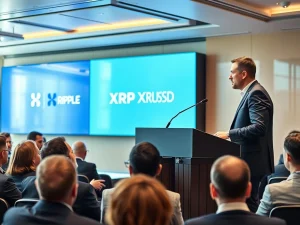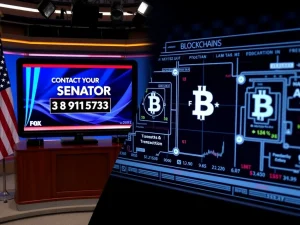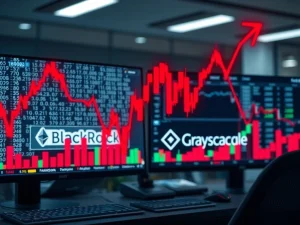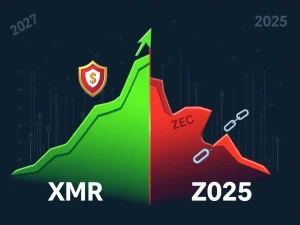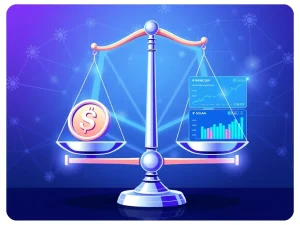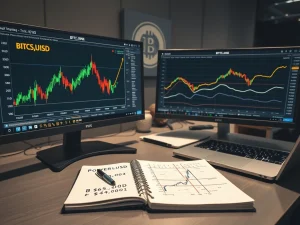Bitcoin’s Pivotal Surge: Crypto Market Confronts Fed Policy, Treasury Moves, and Global Tariff Disputes

The cryptocurrency world is at a critical juncture. Bitcoin (BTC) has recently shown resilience, surging 8% and pushing the total crypto market capitalization close to the $4 trillion mark. This impressive momentum, however, faces a significant test as the market navigates a complex web of macroeconomic and geopolitical events in the final week of July. For anyone tracking Bitcoin News, the coming days are set to define the trajectory for the rest of the year, with pivotal decisions from the Federal Reserve, the Treasury Department, and ongoing U.S. trade policy debates.
Bitcoin News: A Critical Juncture for the Crypto Market
The cryptocurrency market, with Bitcoin hovering near $119,000, is poised on the edge of major shifts. The recent 8% rise in Bitcoin’s value has instilled a sense of optimism, yet analysts caution that this momentum’s sustainability depends on how key macro factors unfold. The total Crypto Market capitalization currently stands at $3.81 trillion, just shy of the $4 trillion threshold. This period is not just about price movements; it is about the fundamental interplay between traditional finance and digital assets. Traders are watching closely as global economic forces converge, creating both opportunities and challenges for digital currencies.
Decoding Fed Policy: What’s Next for Interest Rates?
The Federal Open Market Committee (FOMC) meeting on July 29–30 stands as the first major catalyst for the market. Discussions around interest rate adjustments are central to the future of financial markets, including crypto. Federal Reserve Governor Christopher Waller recently advocated for an immediate 25-basis-point rate cut. His reasoning points to “temporary” inflation, which he links to tariffs and a strained labor market. This perspective highlights a growing debate within the Fed regarding the nature of current inflationary pressures.
Prediction markets on Kalshi currently assign a 40% probability of two rate cuts by December and a 13% chance for three. In contrast, Goldman Sachs forecasts a first move in September. Market participants are acutely aware that even a single dovish dissent at the FOMC meeting could significantly accelerate expectations for rate cuts, reinforcing the September timeline. Such a move would typically be seen as positive for risk assets like cryptocurrencies, as lower interest rates reduce the cost of borrowing and make speculative investments more attractive. The incoming Treasury Secretary J. Yellen’s successor, Scott Bessent, has also urged faster action, stating in a July 1 Fox News interview that “tariff inflation isn’t sticky” and the Fed should act sooner if data supports it. The impact of evolving Fed Policy on market liquidity and investor sentiment cannot be overstated.
Treasury Moves: Quarterly Refunding and Liquidity Shifts
Following the FOMC, July 30 will bring the Treasury’s Quarterly Refunding Announcement (QRA). This announcement, detailing the Treasury’s borrowing plans, offers crucial insights into future monetary policy direction. Bessent’s team has hinted at a strategy involving increased issuance of short-term bills to “manage the yield curve.” This approach aims to influence interest rates across different maturities.
For the crypto market, this strategy carries significant implications. Increased issuance of short-term bills could absorb liquidity from the financial system, potentially impacting stablecoin markets and broader crypto liquidity. Stablecoins, which are often backed by short-term Treasury bills, could see shifts in their underlying asset composition and market dynamics. Analysts are meticulously monitoring the maturity mixes in the QRA to assess how these Treasury Moves might indirectly pressure crypto demand and overall market stability. A shift towards shorter-term debt could signal a proactive approach to managing the national debt while also influencing the availability of capital for various asset classes, including digital ones.
Tariff Disputes: A Wildcard for Inflation and Crypto
Trade policy remains a significant wildcard, capable of introducing considerable volatility. A July 7 executive order extended retaliatory tariffs, imposing a 100% surcharge on Chinese imports set to take effect August 1 unless renegotiated. This development has far-reaching implications for global supply chains and inflation. Scott Bessent’s emergency trip to Stockholm underscores the fluidity and urgency of the situation, as diplomatic efforts attempt to avert the full impact of these tariffs.
However, legal challenges could potentially override diplomatic efforts. The Federal Circuit Court is scheduled to hear arguments on July 31 in V.O.S. Selections v. Trump. This landmark case tests the extent of presidential authority to impose tariffs under the International Emergency Economic Powers Act. A ruling against executive overreach could alleviate long-term inflation risks, which would generally be seen as a positive for crypto, potentially reinforcing Bitcoin’s role as an inflation hedge. Conversely, a pro-tariff outcome might entrench higher inflation expectations, dampening BTC’s appeal as a safe haven asset. The outcome of these Tariff Disputes will directly influence economic stability and, by extension, investor confidence in digital assets.
Navigating Volatility: Key Signals for Traders
Bitcoin’s recent 8% price increase coincided with a drop in Treasury yields, with the 10-year benchmark falling to 4.34%. This inverse correlation between rate-cut expectations and real yields is a key dynamic for market participants. Lower yields often make riskier assets, like Bitcoin, more appealing as investors seek higher returns.
For traders navigating this complex environment, monitoring three key signals is crucial:
- FOMC Dot Plots: These provide insights into the Federal Reserve officials’ projections for future interest rates, offering clues about potential tightening or easing timelines.
- QRA Borrowing Structures: The Treasury’s borrowing plans, particularly the mix of short-term versus long-term debt, will indicate shifts in liquidity and monetary policy influence.
- Tariff Negotiation Outcomes: The resolution or continuation of trade disputes will directly impact inflation expectations and global economic stability, affecting risk appetite.
As Forward Guidance host Felix Jauvin noted on X, “Stay frosty—the July events will define the rest of the year.” At press time, the total crypto market cap stood at $3.81 trillion. Traders maintain a cautious approach, balancing optimism over potential Fed easing with uncertainties from trade and legal fronts. The coming days will determine whether the crypto market can withstand these macro pressures or face renewed volatility.
The interplay of monetary policy, fiscal strategy, and international trade disputes creates a dynamic and challenging environment for the cryptocurrency market. While Bitcoin’s recent surge offers a glimpse of its potential, its sustained growth hinges on favorable resolutions to these critical macro events. Vigilance and informed decision-making will be paramount for market participants in the weeks ahead.
Frequently Asked Questions (FAQs)
1. How do Federal Reserve interest rate decisions impact the crypto market?
Federal Reserve interest rate decisions significantly influence the crypto market. Lower interest rates generally make riskier assets like cryptocurrencies more attractive by reducing the cost of borrowing and increasing liquidity in the financial system. Conversely, higher rates can draw capital away from speculative assets towards safer, yield-bearing investments, potentially dampening crypto prices.
2. What is the Treasury’s Quarterly Refunding Announcement (QRA) and why is it important for crypto?
The Quarterly Refunding Announcement (QRA) details the U.S. Treasury’s borrowing plans for the upcoming quarter, including the types and maturities of debt it plans to issue. It’s important for crypto because increased issuance of short-term bills, as hinted by Bessent’s team, can absorb liquidity from the financial system. This absorption can impact stablecoin markets, which often hold these bills, and broader crypto liquidity, potentially affecting demand and stability.
3. How do tariff disputes affect inflation and Bitcoin’s appeal?
Tariff disputes can lead to higher inflation by increasing the cost of imported goods, which then translates into higher prices for consumers. If inflation rises significantly, Bitcoin’s appeal as a potential inflation hedge might strengthen, as investors seek assets outside traditional financial systems. However, prolonged trade tensions and economic uncertainty can also dampen overall market sentiment, potentially leading to sell-offs across all asset classes, including crypto.
4. What key signals should crypto traders monitor in the current environment?
Crypto traders should closely monitor three key signals: the Federal Open Market Committee (FOMC) dot plots for insights into future interest rate timelines, the Treasury’s Quarterly Refunding Announcement (QRA) for shifts in borrowing structures and liquidity, and the outcomes of ongoing tariff negotiations, which impact inflation and global economic stability.
5. Why did Bitcoin rise 8% recently, and is this sustainable?
Bitcoin’s recent 8% rise is attributed partly to dropping Treasury yields, reflecting market expectations of potential Fed rate cuts. Lower yields make riskier assets more appealing. Whether this surge is sustainable depends on the resolution of the macroeconomic and geopolitical events discussed, including the FOMC decisions, Treasury moves, and tariff outcomes. Favorable resolutions could sustain momentum, while negative developments could introduce renewed volatility.



